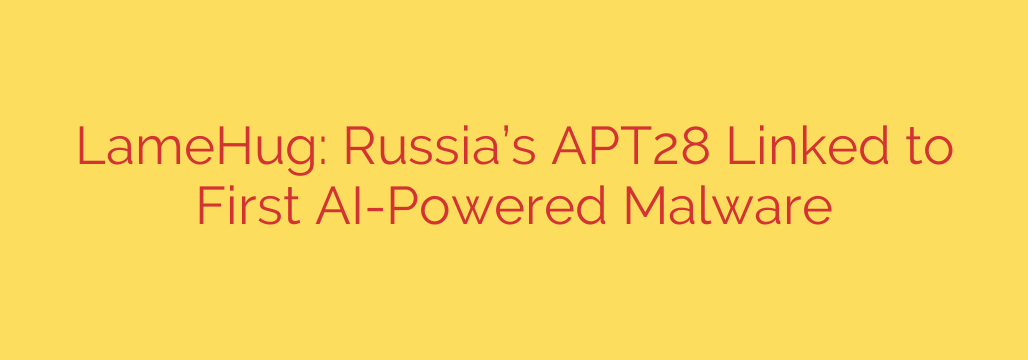
A New Frontier in Cyber Threats: State-Sponsored Hackers Deploy First AI-Powered Malware
The landscape of digital security is constantly evolving, but every so often, a development emerges that represents a true paradigm shift. We have now entered such an era with the discovery of LameHug, the first documented piece of malware actively using artificial intelligence to enhance its attacks. Cybersecurity analysts have linked this sophisticated threat to APT28, the notorious Russian state-sponsored hacking group also known as Fancy Bear.
This development marks a significant and dangerous escalation in cyber warfare, moving beyond pre-programmed attacks to autonomous, adaptive threats capable of thinking on their feet.
Who is APT28 and What is LameHug?
APT28, or Fancy Bear, is one of the world’s most infamous advanced persistent threat (APT) groups. Backed by Russian intelligence, they have a long history of targeting governments, militaries, and political organizations worldwide with highly sophisticated cyber-espionage campaigns.
LameHug is their latest and most alarming creation. Unlike traditional malware that follows a rigid set of instructions, LameHug integrates AI models to make independent decisions once inside a victim’s network. This leap in capability makes it exponentially more difficult to detect and defend against.
The Game-Changer: How AI Elevates Malware Capabilities
The integration of artificial intelligence transforms how malware operates. Instead of relying solely on commands from a remote server, which can be traced and blocked, LameHug can analyze its environment and adapt its strategy in real-time.
Here are the key advantages this AI integration provides to attackers:
- Dynamic Evasion of Security Tools: Traditional antivirus and security software often rely on signature-based detection—looking for known malicious code. AI-powered malware can alter its own code and behavior, making its signature unrecognizable to these legacy systems. It learns what security tools are present and actively works to circumvent them.
- Autonomous Decision-Making: Once it has breached a network, LameHug can perform reconnaissance on its own. It can identify high-value targets, find pathways for lateral movement, and decide on the most effective methods for data exfiltration without needing to communicate with its creators. This reduces network traffic that could otherwise alert security teams.
- Highly Optimized and Efficient Attacks: The AI can analyze the compromised environment to determine the most vulnerable systems and the quietest times to move data, maximizing its chances of success while minimizing the risk of being caught. It essentially customizes the attack for each unique victim.
The Broader Implications for Global Cybersecurity
The emergence of LameHug is more than just a new tool for a known threat actor; it signals the beginning of a new arms race. We are now facing an era where security defenses must fight AI with AI.
Organizations can no longer rely on reactive security models. The speed and adaptability of AI-driven threats mean that by the time a human analyst detects a breach, the damage may already be done. This new reality demands a fundamental shift in how we approach cyber defense, moving from perimeter security to an assumption that breaches will occur and focusing on rapid, intelligent detection and response.
How to Fortify Your Defenses Against AI-Driven Threats
While the threat is sophisticated, defensive strategies are also evolving. Protecting your organization from advanced malware like LameHug requires a modern, multi-layered approach.
- Implement AI-Powered Security Solutions: The most effective way to fight AI-driven threats is with AI-driven defenses. Solutions like Endpoint Detection and Response (EDR) and network detection tools that use behavioral analysis can identify anomalous activity, even if the malware’s signature is unknown.
- Adopt a Zero Trust Architecture: The principle of “never trust, always verify” is more critical than ever. A Zero Trust framework authenticates every user and device attempting to access resources on your network, regardless of their location. This contains breaches by preventing malware from moving laterally with ease.
- Enhance Threat Hunting and Monitoring: Don’t wait for an alert. Proactive threat hunting, where security teams actively search for hidden adversaries in the network, is essential. Continuous monitoring of all network activity can help spot the subtle indicators of an AI-powered compromise.
- Prioritize Security Awareness Training: The human element remains a key entry point. Ensure employees are rigorously trained to recognize phishing attempts and social engineering tactics, as these are still the most common methods for delivering an initial payload.
The arrival of LameHug is a wake-up call for the entire cybersecurity community. The era of intelligent, autonomous malware is here, and it demands our immediate and focused attention. The old security playbook is no longer sufficient. Staying informed, investing in modern defenses, and adopting a proactive security posture is our best defense in this new and challenging frontier.
Source: https://securityaffairs.com/180092/apt/lamehug-first-ai-powered-malware-linked-to-russias-apt28.html








